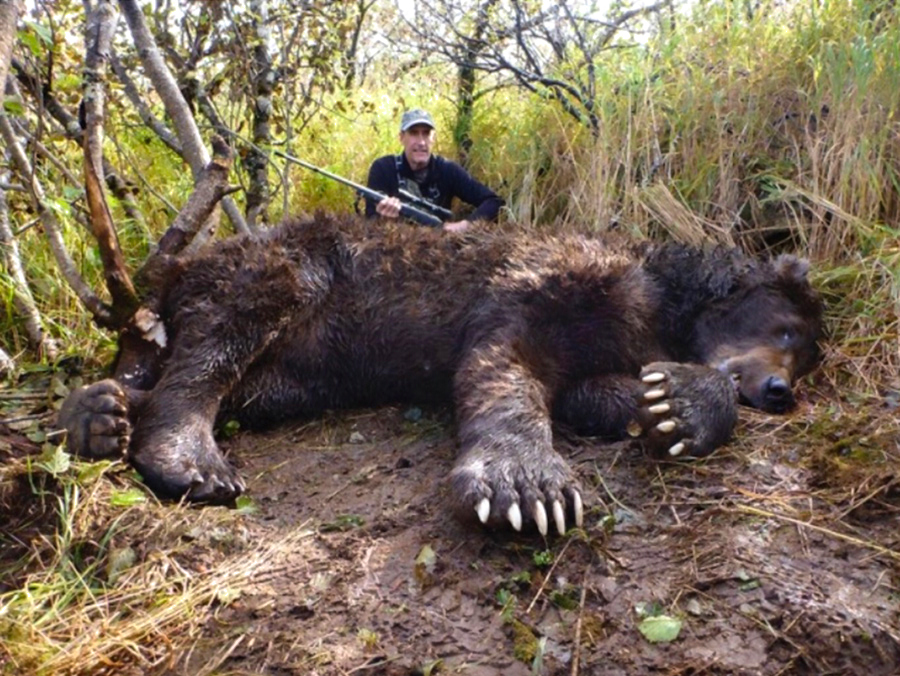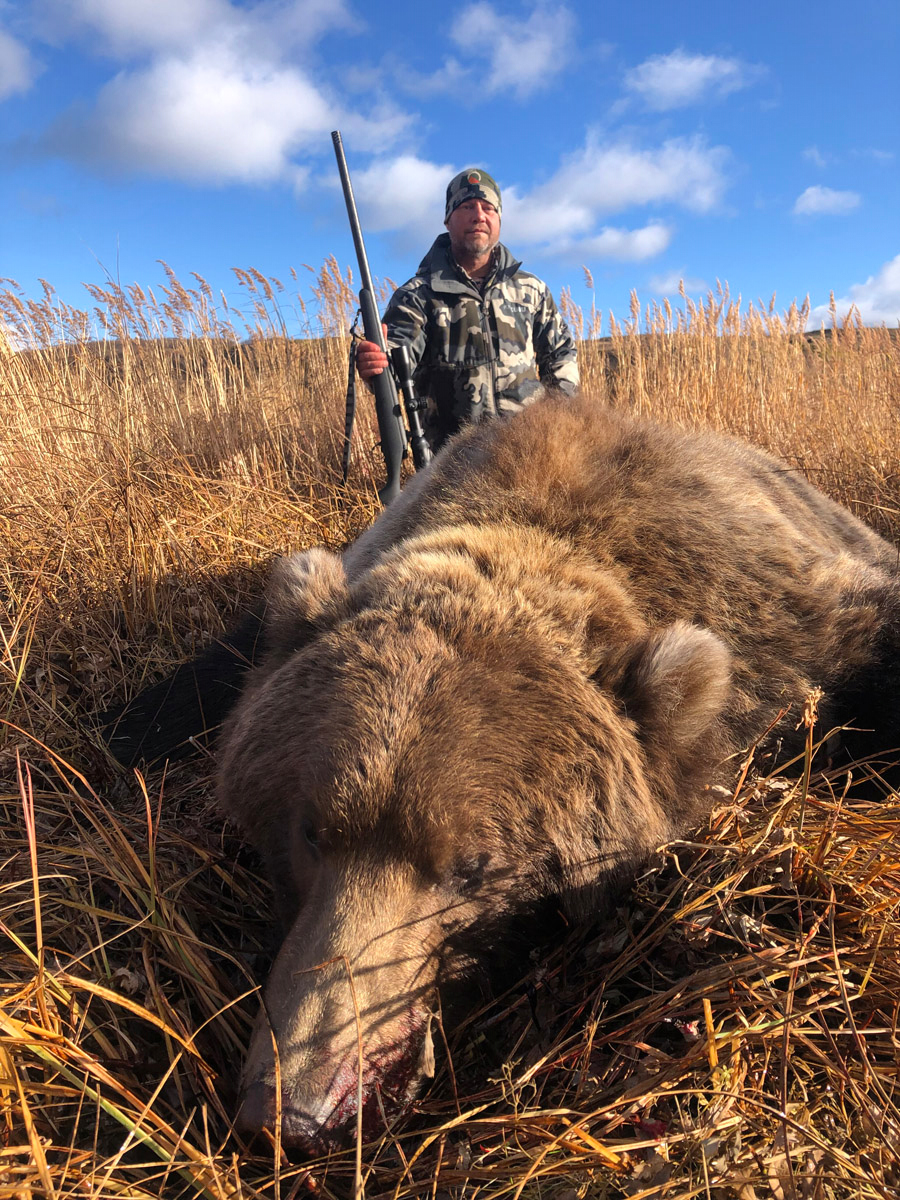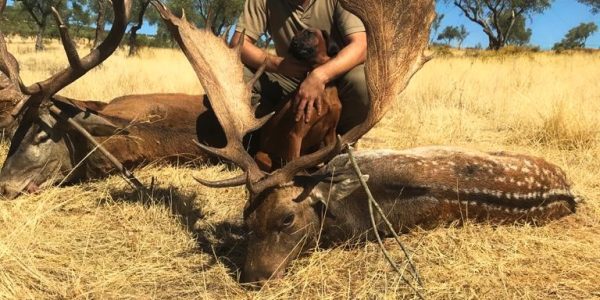
Spain Balearen Goat
Spain is blessed with a mild Mediterranean climate and a wide variety of terrain. With mountains in the north, south, […]
- Success Rate99%


If you are looking for the best chance to take a giant Brown Bear, the Alaska Peninsula is the place to hunt. This is a 10 or 15-day hunt for beautiful Brown Bear on the Alaskan Peninsula. These Brown Bear average about 9 feet tall!
Our exclusive bear hunting area is approximately 550 square miles in size, over 352,000 acres.
The area includes over 100 miles of coastline on the Pacific coast.
The area supports an excellent Bear population, with one of the highest cub survival rates anywhere in Alaska. This is due to harvesting a high percentage of large boars. Large boars kill and eat many cubs (53% statewide) before they reach 3 years old.
The area is so large that we utilize up to 12 spike camp locations to put you within walking distance of the best hunting areas. These spike camps are accessed by super cub or riverboat and are located near good vantage points, where you will be able to glass valleys, streams, and hillsides.
Hunters are allowed 10 wolves per day!


Discounted Price: $24,950
2022 Hunt Dates
Spring Bear season is May 10-25, 2022
10-day hunts: May 10-19th
16-day hunts: May 10-25th.
No Bear Season in October of 2022
2021 Spring hunters went 7 for 9 with 2 hunters opting out of opportunities on 9.5 foot Bears.
CALL JOSHUA FOR AVAILABILITY AT (936) 524-2569
Discounted Hunt Price: $24,950 (Reg. $26,950)
LICENSE FEES (NON-RESIDENTS - UNITED STATES):
LICENSE FEES (NON-RESIDENTS - ALIEN):
Accommodations
Meals
Guide
Travel to and from destination
Licenses and Tags
Alcoholic Beverages
Trophy handling out of the country
Tips and Gratuities


No, Alaska state law prohibits guaranteeing success, on any given hunt or trip.
All camping equipment, food, sleeping bags, pads, cots, boats, motors and bush airplanes used during the hunt. All licenses and tags will be purchased when you arrive in base camp.
You will be personally guided by a licensed guide. All field care of your skins will be handled by your guide. You will be staying in comfortable tent camps with cots, stoves, and lanterns.
Windy and cloudy most of the time. Rain and snow 50% of the time. Temperature is usually 20-50 degrees above zero. You will be sitting for long periods of time (16-18 hours per day) glassing for bears, 8-10 hours per day glassing for moose. Warm layered clothing is required. If we had white sandy beaches and warm weather on the Alaska Peninsula, there would be condos there instead of bears and moose. Plan for the worst weather you have ever hunted in, then if the weather is nice a couple of days, you get the prize for good weather.
You will start hunting the day following your arrival in spike camp. It is illegal to shoot any big game animal the same day you are flying. Our hunting area is approximately 550 square miles in size, including over 100 miles of coastline on the Pacific coast. Although the area supports an excellent bear population, we plan to take only 12-14 animals per season. We also try to harvest only mature animals, which helps to maintain an excellent bear population.
Our camps are located near good vantage points, where you will be able to glass valleys, streams, and hillsides.
You do not need to bring a sleeping bag. We furnish good, clean sleeping bags, pads and cots for all customers. Is you are very tall or heavy and want to bring your favorite sleeping bag, please feel free to do so. We will still have one of ours available if needed.
You should bring at least a very large good day pack with a hip belt, or better yet would be a framed pack with a good hip belt. You will be carrying your camera, extra shells, rain gear, a jacket, your lunch, and snacks, plus your water bottle. Then add about 5# of misc. stuff you will probably never use, but like to carry just in case.
The best frame pack on the market is sold by Barney’s Sports Chalet in Anchorage. It is a well built, with heavy-duty shoulder straps and hip belt. This is what 95% of all the guides use.
Please bring only small/medium duffel bags. The perfect bag is Cabela’s medium size duffel bag. Please, no suitcases or 6-foot long duffel with wheels on them, commuter airlines charge for over 50#, and now your gun case counts as one piece of baggage.
Our Super Cub planes are 1 passenger aircraft, with 50# of baggage, including your gun case. You will only need two (2) sets of hunting clothes, plus your traveling clothes.
If your gear requires an extra flight, there will be an additional $600.00 charge.
Ankle fit hip boots are hip boots with a tight-fitting ankle. This tighter fit keeps the boots from moving up and down when you walk. By not rubbing on your heel, there is less chance for blisters. You can purchase these from Cabela’s, they call them contour ankle fit. They come in both insulated and uninsulated, and with regular boot sole or air-bob soles. I recommend uninsulated ones with the air-bob soles. Consider buying one size larger than you normally wear and then buy two (2) pairs of felt insoles. Place an insole in each boot. The insoles give you and extra padding for walking on river gravel and also absorbs the moisture. Plan on changing the insoles daily.
The best shape possible. You do not need to be a marathon runner, but you need to be able to walk up to 5 miles in ankle fit hip boots daily.
When bear hunting we often are glassing areas 1-2 miles away. If a bear is spotted, that you want, you need to be able to get close enough for a shot. The only time when this is critical is right before dark when there may not be enough time to poke along at a snail's pace. Usually, you will have enough time to work into place at a normal walk, unless a bear is traveling and you are trying to cut him off. Most of our spike camps are within 1 mile of a good lookout or vantage point.
To get in shape, I recommend climbing stairs or hills. Walking on flat ground doesn’t help you as much as you think. If you have a pack frame, put it on and start climbing. After a couple of days, add a couple of gallon milk jugs full of water. Climb the hills or stairs and when you get to the top, you can dump the water and start back down. Coming down hills or stairs with lots of weight in your pack is very hard on your knees. Work your way up to where you can climb with 5 gallons of water or 40 pounds. That is more than you will need, but you will think the 20-pound load for your hunt, is really light then.
All hunting is done, by walking from spike camps. This is strictly a fair chase hunt. Please be capable of walking five (5) miles daily in ankle-fit hip boots. Your guide will always carry his own rifle while hunting.
Yes, you should bring the best binoculars that you have or can afford. Most guides will be carrying 10X40 Zeiss, Leica or Swarovski. Any good 8X30 or 10X40 will be a big advantage to your hunt. Many customers are excellent spotters, and you will be sitting for hours looking through your binoculars.
Just ensure that they are waterproof because the Alaska Peninsula weather will test your gear.
Yes, every hunter should bring a camera for taking quality pictures of their adventure of hunting in Alaska. I recommend a digital camera with a couple of extra batteries or battery charger. A built-in telephoto lens is nice. The one comment I get often is that “I wish I had taken more pictures”. Alaska is a cameraman’s, dream come true.
No, every guide will be carrying a good spotting scope and tripod. This will save you about 5-7 pounds in gear weight.
I recommend at least a 7mag or larger. More Bears are taken with a 300mag than any other caliber. If you are buying a new rifle to hunt Alaska, get a 338 mag. The 338 is a perfect rifle for everything in Alaska. If you can handle the recoil of a 375mag, then that would be a good choice also, especially for large Brown Bears. Well bonded bullets such as Noslers, Swift or Barnes are the best.
I carry a 375 mag., pre 64 model 70, with a fiberglass stock. My rifle is lightweight, has a 20 ½” barrel, and a 1.5–5 power Leupold VarXIII scope. I shoot only 300 grain Nosler bullets in Federal factory loads.
Your scope is actually more important than your rifle. Bring only a good waterproof scope, that will not fog up in the rain. Lens covers are a must. You will not need anything larger than a 2X7 or 3X9 power scope. Please no 6X20 power scopes, we are not shooting prairie dogs
The stainless steel actions and fiberglass stocks are the best for Alaska because your rifle is going to be wet 90% of the time. Trust me.
This is probably the hardest question. We have received tips ranging from a Desert Sheep hunt in Mexico for just getting the client a nice trophy, to zero for getting a client a super trophy. One man sent his son and son-in-law on a bear hunt and they took 2 bears in 2 days. He told them to tip the guide 10% of the hunt price, that came to a $2,200 tip. I paid the guide $2,000 in wages, so you can see the guide had a good hunt, as well as the clients. I pay my guides very well to keep them coming back year after year, and they are expected to provide you with a very high-quality hunting experience. It’s the additional effort the guide puts forth to ensure you have a great hunt, that you should be tipping for. The average is probably about $1,000.00 on a bear hunt and $500.00 on a moose hunt. Some clients tip the packers, cook, pilots, as well as your personal guide. The tipping amount is up to you, and I don’t want you to think I am telling you that a big tip is required or expected.
We have a good selection of spinning rod and reels at the lodge for you to use. We also have a good selection of lures. If you want to fish with a fly rod, then you will need to bring your own gear and flies.
A 7-9 weight rod, 8-9 ½ feet in length, and a mid-size reel with a disc or caliper drag, that can handle a full floating or sink-tip fly line plus 150 yards or more of 20lbs backing. This is perfect for situations that require long casts, fast sinking lines, or the power to lift fish from deeper water. Great for Silver Salmon or large Char and Trout.
RECOMMENDED FLIES: An assortment of bunny leeches, egg-sucking leeches, wooly buggers and flesh flies tied on # 4 and # 2 hooks should be in every angler's fly box. Black, purple, olive and dark red are the preferred colors, but throw a couple of loud color ones (chartreuse or hot pink) in your box also if you can. Egg patterns, lots of them, are also a must, and they should be orange, red and hot pink, tied on # 8 & 10 hooks. Spawn sack flies like the Babine Special, the Alaskan Omelette, and the Polar Shrimp, on white or tan with bright orange, pink or red, and tied on # 4 & 6 hooks are also hot producers. These flies will work on just about everything that swims in Alaska.
A selection of high-vis flash flies on 1/0 and # 2 hooks are also very important, particularly for salmon, which strike flies out of reflex rather than hunger. Some of the best known are the Karluk Flash and the Salmon Flash Fly-in purple, silver, and in gold, Mercer's King Caviar, the Boss Bunny, the Comet Bunny, the Christmas Tree, and the Wiggle Tail.
Bring two (2) boxes of the exact same ammo that you have sighted your rifle in with at home.
Sight your rifle in 3” high at 100 yards. Then you can hold on the animal out to 300 yards. Very seldom do we ever take a shot over 200 yards. Usually, the average shot is 150 yards.
Please shoot your rifle at least 50 times before you come and get use to it, and know where it shoots. I had one hunter who came on a Bear hunt who had never shot his rifle once, only had it bore-sighted at the gun shop where he bought it. Another hunter said he had his wife sight in his 338 for him. He had never shot his rifle either until he arrived at camp.
You should practice shooting kneeling, sitting, and a little offhand.

Ankle fit unisulated hip boots
(Consider one (1) size larger than you normally wear) or Simms G3 Wader pants and Simms G3 boots.
2 pairs of felt insoles for inside your hip boot. Change daily.
Rubber camp boots
Warm Outfitter's Fleece camo jacket
Wool and Goretex gloves
Rifle, Sling, Scope covers and 40 rounds of ammo. (Same as you sighted in with)
Small hard gun case
Shaving kit and medicine
Rain pants & ¾ length guide coat (Helly Hansen Impertech guide coat)
Camera, charger, batteries and film/cards
2 Camo Microtex Shirts
2 pairs of Long MTP Medium-weight underwear
4 pairs of Poly-pro socks
1 pair of Jeans or Carhart pants
1 pair of Microtex camo pants
Sunscreen and lip balm
Water bottle/canteen - Stay hydrated!
4 pairs of Wool boot socks (Smartwool)
6 changes of MTP underwear
Warm hat and stocking cap
Binoculars (10X40)
Flashlight and Headlamp with extra batteries (Mini-Mag AA)
Extra GI duffel bag for skins
Insect repellant & sunglasses (100% Deet)
Moleskin for blister control
Skinning Knife (optional)
Hybrid Hunter 2-in-1 pack or small frame 2200 Day Pack (These can be used for your carry-on airplane bag.)
Fly to Anchorage on the airlines you choose. When you arrive in Anchorage you will spend the night and the following morning fly south to our lodge on the Alaska Peninsula where you will be picked up by our charter.
The Alaska Peninsula (also called Aleut Peninsula or Aleutian Peninsula) is a peninsula extending about 800 km (497 mi) to the southwest from the mainland of Alaska and ending in the Aleutian Islands. The peninsula separates the Pacific Ocean from Bristol Bay, an arm of the Bering Sea.
In literature (especially Russian) the term ‘Alaska Peninsula’ was used to denote the entire northwestern protrusion of the North American continent, or all of what is now the state of Alaska, exclusive of its panhandle and islands. The Lake and Peninsula borough, the Alaskan equivalent of a county, is named after the peninsula.
Fence type: Open
Languages spoken by staff: English
Operating since: 1971
Wall tents with wood stoves and bomb shelter tents. There are 14 spike camps outside of the main lodge.
Nearest airport: Anchorage
Miles to airport: 200
Transfer from airport: Yes
Transfer from railway: No
NOTICE: Please be advised some places you wish to hunt may have regulatory restrictions if you have been convicted of certain crimes. This may prevent you from hunting or entering a country.

Spain is blessed with a mild Mediterranean climate and a wide variety of terrain. With mountains in the north, south, […]

Spain is blessed with a mild Mediterranean climate and a wide variety of terrain. With mountains in the north, south, […]

Spain is blessed with a mild Mediterranean climate and a wide variety of terrain. With mountains in the north, south, […]

Spain is blessed with a mild Mediterranean climate and a wide variety of terrain. With mountains in the north, south, […]

Spain is blessed with a mild Mediterranean climate and a wide variety of terrain. With mountains in the north, south, […]

Spain is blessed with a mild Mediterranean climate and a wide variety of terrain. With mountains in the north, south, […]

